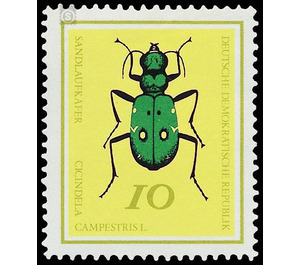Useful beetles - Germany / German Democratic Republic 1968 - 10 Pfennig
Theme: Animals
| Country | Germany / German Democratic Republic |
| Issue Date | 1968 |
| Face Value | 10.00 |
| Color | yellow |
| Perforation | K 13 1/2: 13 |
| Printing Type | offset |
| Stamp Type | Postage stamp |
| Item Type | Stamp |
| Chronological Issue Number | 1153 |
| Chronological Chapter | GER-DDR |
| SID | 815117 |
| In 26 Wishlists | |
Useful Beetles The Ministry of Posts and Telecommunications of the German Democratic Republic issues six multicolored special postal stamps with pictures of useful beetles. Useful beetles The total number of beetles living in Central Europe is difficult to specify; Sure, there are a few hundred species. The difficulty arises not least from the fact that the concept of usefulness is difficult to define. There are many beetles that play an important role in the household of nature and are therefore indirectly useful. Many Silphidae (carrion beetles) eliminate animal carcasses, the dung beetles bring feces under the ground, Georyssidae and Heteroceridae eliminate organic sludge at pond and stream edges. These are very important and useful activities. This circumstance should not be forgotten when talking about beneficial beetles, because in general one thinks first of all of beetle species that play an important role in the natural control of pests of agriculture or the forest. Many ground beetles (Carabidae) eat the terrestrial pests living on and in the soil, many short - winged (Staphylinidae) and long - tailed beetles (Histeridae) kill fly larvae, not a few beetles (Nitidulidae), flat beetles (Cucujidae), almost all colored beetles (Cleridae) track the pests of the Woods in their brood lobes, ladybirds, the larvae of numerous species of soft beetles (Malachiidae), Cantharidae, Dasytidae, etc.) eat leaf and stem pests. The motif series shows some because of their usefulness to be gentle, but less beneficial as beetle species. 10 Pfennig value: Cicindela campestris L. The field sand beetle Cicindela campestris L. belongs to the family Ground Beetle (Carabidae). It occurs throughout Europe, North Africa, the Caucasus and throughout Siberia. Like all sandbar beetles, he is a ravenous predator that destroys a large number of other insects, many of them harmful. In the warm sunshine, the beetles are very mobile and fly in sandy areas in low altitude lightning fast. Unlike most other beetles, they look very good and are also very sensitive to ground vibrations. If a Cicindela sits in the hot sand, you can approach her only to two steps, then she flies up and sits down a few yards, head down, with big bulging eyes towards the troublemaker. The larva sits during the day at the upper end of a spring-keen vertical ground tube, which closes it with the head. As soon as an insect, a spider or a small worm crawls past the opening of the tube, the larva snaps its head up, grabs the victim and pulls it down to the bottom of the tube. Here, the prey is consumed and the indigestible remains are finally transported out. The development cycle of the species lasts one year.


